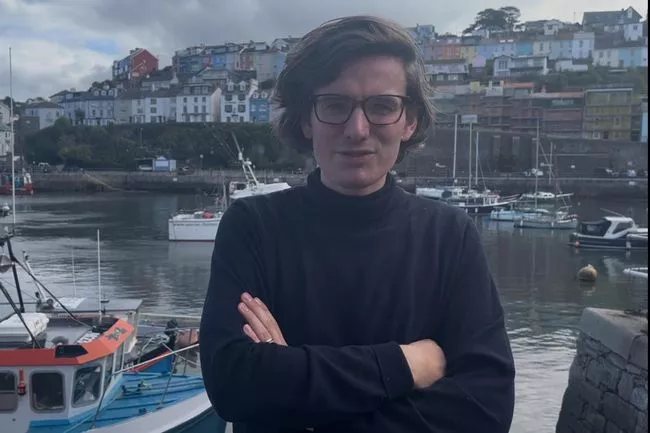Torquay, which sits at the northern end of Torbay in Devon, is a town that attracts as much hate as it does love so one reporter went to find out why
Stand on the boardwalk of Torquay when the sun is shining, and it’s easy to forget you’re in the UK and not on the Med.
Rows of palm trees sway in the breeze, the sea laps onto a long sandy beach and white art-deco buildings sit on the hill above. Look a bit harder, however, and there are signs you’re in the English rather than the French Riviera.
I’ve not visited Saint-Tropez before, but I’m fairly confident fish and chip shops, bucket and spade emporiums and 2p arcades aren’t major fixtures on the Côte d’Azur. The average July day in the Devon town of 50,000 is 20C and a bit cloudy, while the French Riviera enjoys 29C days of sunshine and blue skies.
READ MORE: Holidays to sun-soaked island with £3 beers and 30C October weather just got cheaper
Comparisons between the Devonshire coastline and the glitzy French region originated in the Victorian era, when visitors compared the warm microclimate and beautiful scenery of Torbay, a 22-mile stretch of the South Devon coast with Torquay at its northern end, to the 186 miles of the original Riviera.
While the French Riviera is sometimes criticised for being too hot, a bit snobby, and expensive, Torquay occasionally comes in for harsh words of a different variety. In fact, it seems to get a disproportionate amount of heat. Last year, a Which? survey named Torquay as Brits’ least favourite seaside town, while The Telegraph named it as its 13th worst coastal spot. Even one of my cabbies stuck a boot in, condemning the high street as a “dump”.
How the judges of those competitions came to their conclusion is something of a mystery to me, and their poor taste in coastal spots is obvious. After a weekend break in Torbay, I came away enchanted and intrigued by Torquay — a seaside town that is unlike any other I’ve come across in the UK.
One of the town’s strongest and most delicious qualities is its food. Of course, you can get a classic cod and chips every 10m along the seafront as you can in most UK seaside towns, but Torquay also offers a lot more.
I was lucky enough to get a whistle-stop tour of the town’s culinary scene through an invitation to the 7 Chefs event on October 4. Over the course of seven hours, guests experience seven different seafood dishes, each created by a different chef and served in a different independent restaurant.
The annual event is a hot ticket, stopping off as it does at the Michelin-starred Elephant for a spot of braised octopus, brother-and-sister-run Ollie’s for a very generous lobster thermidor, delicately prepared oysters at No.7 Fish Bistro and Offshore to try its katsu take on mussels.
If you love gorging yourself on the highest-grade seafood and British-produced wines going, then this is the event for you. It may take place just once a year and cost £120, but you’ll need a good 364 days’ break to digest once you’ve taken on diver-caught scallops at The Yacht, a not-so-mini portion of fish and chips at Pier Point, and cheese and too much port at Twenty1 Lounge.
“Lightweight,” one of my new gourmet pals called after me as he got another couple of reds in for good measure, while I heaved my creaking body into a taxi.
The event is also run in Brixham on the other side of the bay. The multi-coloured, boutique village is home to one of England’s biggest fishing markets and eateries, including Olive, The Prince William, and The Mermaid, where many of the 40 fish and shellfish species landed here are eaten.
Torquay is sometimes called ‘the Queen of the English Riviera’, and for good reason. On a sunny day, the grand art deco houses crest the hill overlooking the bay, twinkling in the sunshine like jewels in a crown.
Torbay sits just past the western end of the Jurassic Coast and is made up of Devonian limestones cut through with red ochre deposits. These create a complex landscape with features like the wave-cut Berry Head platform and natural caverns.
On Sunday afternoon, Nigel Smallbones, the ranger at Berry Head Nature Reserve for a 27 year stint, showed me around, pointing out where the 1,600-guillemot-strong colony roosts, the cave system where his son monitors the 56 resident horseshoe bats, and how rock fans come from as far away as China to enjoy the geology.
Half an hour’s drive round the bay found me down within the rock formations at Kents Cavern — a prehistoric cave system excavated by some hard-as-nails Victorians. It’s a dramatic place that keeps delivering major scientific discoveries, including the jawbone of a Neolithic girl probably eaten by cave hyenas, and a massive bear skull.
If a tour of the stalagmite-and-tite-filled cavern isn’t your thing, then just up the road is a piece of British comedy history — the hotel where John Cleese had the inspiration for Fawlty Towers. Perhaps because of the slightly damning association, the hotel is long gone, replaced by a block of flats and a blue plaque.
Another fundamental difference between the Rivieras is their attitude to boozing. I was genuinely shocked and impressed by how much my fellow restaurant crawlers put away, and how some of them had steady enough stomachs for a fry-up on a sunrise boat trip the following morning.
You’d struggle to find people of such passion and stern stuff on the French Riviera.
Locals I chatted to conceded that the nightlife in Torquay isn’t what it once was, a number lamenting how two clubs that offered all-you-can-drink for less than a tenner are now long gone. However, the party spirit lives on in the form of the 1,200-capacity Arena Torquay, which hosts an Ibiza throwback night next week, and a row of bars down on the quayside.
Given the marauding groups of stag and hen dos, some dressed in lederhosen in respect of Oktoberfest, Torquay is still considered a good place to party.
Devon’s mild climate and wind mean its growing vineyard scene produces light, crisp wines that pair well with fish—a happy coincidence. Torquay also has a number of gin distilleries. Laurance Traverso, director of the Coastal Distillery Co, poured me a delicious G&T from his base down by the water.
So why the hate?
There is, undeniably, a section of the British public that doesn’t like Torquay. If you arrive on a family holiday and have the misfortune of getting rained on for a week, I can understand it.
Some residents of the town have grown frustrated with the high street and how areas away from the seaside and the gaze of tourists have become run-down. Local Sophie Ellis-Marsden explained: “I avoid that end of town. I don’t have much nice to say, to be honest. The waterfront is lovely, and that’s the only thing that is.
“It’s nice, don’t get me wrong, I moved here from Milton Keynes for the sea, but it needs more work. More shops just seem to be shutting down. Everything’s gone, and I don’t really know why.”
The council seems committed to sorting out these issues. There has been some serious investment, with plenty more in the pipeline. The Strand at the harbourside has been turned into a piazza-style promenade, with wider pedestrian areas for dining and seating, and better public transport links.
A former Debenhams department store is set to be demolished, replaced with new homes, cafés, restaurants, and an upmarket hotel. There are plans in the town centre too, and further development at The Strand, which the council predicted would provide about 80 full-time jobs, £32 million in wages, and bring 86,000 new visitors over a 30-year period. The entire cost of the scheme is reported to be £70 million.
How to visit
The official English Riviera site has plenty of suggestions on where to stay and what to do.
The train from London takes three hours from Paddington to Torquay.


